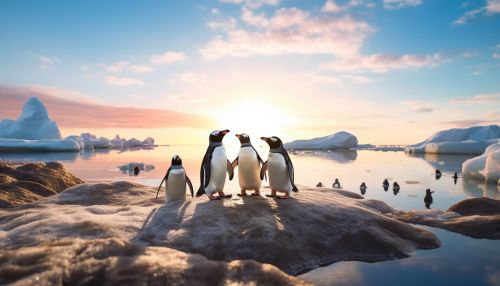Penguins
Introduction
Penguins (order Sphenisciformes, family Spheniscidae) are a group of aquatic, flightless birds living almost exclusively in the Southern Hemisphere, especially in Antarctica. They are highly adapted for life in the water, with their distinct tuxedo-like appearance being a form of camouflage while swimming. Penguins have become iconic symbols of the polar regions and are subjects of numerous studies due to their unique adaptations to harsh environments and complex social behaviors.
Evolution and Taxonomy
The evolutionary history of penguins is a subject of ongoing research. The earliest known penguin fossil is Waimanu, which lived in the early Paleocene epoch of New Zealand, about 62 million years ago. This suggests that penguins diverged from their closest common ancestors, the tubenoses, not long after the end-Cretaceous extinction event. The penguin lineage underwent a rapid burst of evolution with at least 10-14 species present by the end of the Eocene epoch.
Penguins are classified under the order Sphenisciformes, which is composed of one family, the Spheniscidae, and contains 18-20 species spread across six genera. The largest living species is the Emperor Penguin (Aptenodytes forsteri) which can reach up to 122 cm (48 in) in height and weigh between 22 to 45 kg (49 to 99 lb). The smallest penguin species is the Little Blue Penguin (Eudyptula minor) also known as the Fairy Penguin, which stands around 33 cm (13 in) tall and weighs 1 kg (2.2 lb).


Anatomy and Physiology
Penguins are superbly adapted to aquatic life. Their wings have evolved into flippers, useless for flight in the air. In the water, however, penguins are astonishing swimmers, and some species can reach speeds of up to 20 km/h. Penguins have a thick layer of insulating feathers that keeps them warm in water, and an outer layer of feathers that are waterproof due to the oil produced by the penguin's preen gland.
Penguins have a number of physical adaptations that aid in their ability to dive. These include a highly developed gland to filter out salt from their bloodstream, allowing them to drink seawater while they are at sea for months at a time. They also have solid bones to reduce barotrauma when diving, and their kidneys are adapted to recycle precious nutrients that would otherwise be lost in urine.
Behavior and Ecology
Penguins are social birds that form breeding colonies numbering in the tens of thousands. They have a variety of communication methods, including visual and vocal signals. Penguins primarily feed on krill, fish, squid, and other forms of sealife caught while swimming underwater. They spend half of their lives on land and half in the oceans.
Penguins are known to have a variety of mating behaviors. Most penguins are monogamous, with pairs forming long-term bonds that last multiple breeding seasons. Some species like the Emperor Penguin are serially monogamous, forming a new pair bond each year. Penguins invest a significant amount of time and energy into parental care, with both parents participating in incubation and chick-rearing duties.
Conservation
Many penguin species are threatened or endangered, primarily due to climate change and human activities. The Galapagos Penguin (Spheniscus mendiculus) is one of the species most at risk, with an estimated population of just 1,200 individuals. Conservation efforts are underway to protect and preserve these unique creatures and their habitats. These include establishing protected areas, controlling invasive species, and implementing sustainable fishing practices.
